Eolus One is developing what I think might be the first major business application using OpenSim. OpenSim is the BSD Licensed Open Source Initiative that has evolved from Second Life. Eolus has several client projects that will utilize the secure virtual control centers to improve and document facilities management with sites on OpenSim.
The picture shows the architecture of the system with the OpenSim, SAP and Building Automation Server (VWCI) part of the Eolus One facility management project.
Bruce Sterling at the end of Shaping Things†asks for humankind to start to make “decent technology:”
This whirring, ultra-buzzy technology can keep track of all its moving parts and when its time inevitably comes, it would have the grace and power to turn itself in at the gates of the junkyard and suffer itself to be mindfully pulled apart. It is a toy box for inventive meddlesome humankind that can put its own toys neatly and safely away.
If you are not yet in tune with “the internet of things” here is a music video Royksopp’s “Remind Me” that Sterling suggests is some kind of “spime” theme song.
The closing words of Sterling’s great visionary book on “spimes” and “the internet of things” are:
Its not enough to think about that, or even write about. If it is to be any use to humankind, it will have to get done.
This post is about some people who are doing it!
See the exclusive interview with Oliver Goh and Michael Osias later in this post!
This giant step in the integration of “real” and virtual worlds on OpenSim comes out of a meeting of two minds and the integration of the two virtual world interfaces.
Oliver Goh (avatar Eolus Mcmillan on Second Life) is a paradigm engineer for the large Swiss civil engineering and construction company Implenia Global Solutions pioneered the Eolus Virtual Worlds Communications Interface that communicates between Second Life and most common building protocols (see my earlier post). And Michael J. Osias, Chief 3D Architect for the IBM IT Optimization Business Unit (avatar Illuminous Beltran) Michael (see my earlier post) is the architect of a virtual worlds integration middleware – The Holographic Enterprise Interface.
By integrating the capabilities of their two virtual world interfaces – the Eolus’ VWCI solution with the IBM middleware (HEI) – they are creating a virtual cockpit on OpenSim with extensive capabilities. Michael gave the analogy to Nasa’s mission control.
We’ve got the facilities data (from the Eolus VWCI) and IT data using the shared infrastructure (HEI) and rendered together. To use an example, like mission control for NASA, They’ve got rockets, they’ve got computers, they’ve got people on the ground, but they build this control center, because the want to know whats going on with any of that stuff. So its all integrated into a single operational picture.
Eolus One is creating on OpenSim one of the first (always risky to say the first) Platforms for the Facilities Management Industry (see my earlier post on “The Operating System for Planet Earthâ€). But before continuing this story here is a quick primer on Eolus One.
Eolus One – the Future of Facilities Management.
I blogged the Eolus One’s launch of their public sims and Virtual Worlds Control Interface in Second Life at the beginning of July (see here). At that time, Eolus One in Second Life had already an exhibition hall showing the early development of the VWCI, a demonstration of a virtual operations center and several protoype/use cases showing the cabilities of VWCI, a better planet initiative including Uthango Social Investments and SODIS, and regular music programs led by the amazing Jaynine Scarborough. But since then Eolus has been expanding fast behind the scenes.
Oliver Goh has led the the charge on Eolus One putting together several collaborations that range from “future retail center” (an initiative with Migros, SAP Research, HP) to a control center for an international hotel chain, and a project with the University of St. Gallen to produce a prototype for a “smart” apartment for an elderly person called “Independent Living.”
“Independent Living”
“Independent Living” is an innovative home health care solution using sensor technology, medical monitoring devices and a modern communication infrastructure to help seniors live safely and independently at home.
The virtualisation of an elderly person’s daily movements, sleep, medication routines, and vital signs through a PCM – personal condition monitor – worn on the wrist (see picture below) will allow a health care worker to see easily if something is wrong, or out of the ordinary, and to make the appropriate intervention.
PCM – Personal Condition Monitor
The PCM (device detail above) reports to the Eolus VWCI at all times during the elderly persons sleeping and waking activites.
- The PCM is the size of a wrist watch, it monitors the vital stats (Temp, pulse, motion) of the person
- it is gps enabled
- has a button to manually activate an alarm
- automatic danger detection (posture, motion, body temp)
- automatic or manual delivery of alert
Nokia n810 and VWCI
Eolus is working on a project to use the Nokia N810 to enhance the possibilities of the VWCI. The enhancements made will be in the area of Parts Management, Plant Maintenance and Field Service.
- reduce time to invoice by 55%
- compliance to service level agreements
- faster service delivery (increase in service revenue)
- improve customer satisfaction
- increase field productivity by 25%
- using maEmo and OS2008 to bring new services to the service teams
“Smart” buildings – making a visionary idea happen
Eolus One is not just bringing the facility management processes into virtual worlds to increase energy efficiency, CO2 reduction and transparency of energy consumption which are now global necessities. Eolus is taking the vision of “smart” buildings into new territory by exploring many ways to bring the previously “dead” systems that we live and work in (dead in the sense that up until now these structures and the appliances in them have been unable to communicate to us) into an online virtual environment where we can have a dynamic relationship with all the objects and infrastructure we depend on. So the world of objects can contribute relevant information and content to our lives.
The pictures on the left are the Implenia Global Solutions Office building, in the center the hotel, and on the right Adaxsys a the production facility for electronic components (where the Eolus VWCI is manufactured). All three facilities are used as reference sites for the Eolus VWCI.
Next on the table for development Oliver has suggested may be plug and play modules based on the Eolus VWCI that will bring the kind of facility management now only possible in large scale facilities into every home. Will this mean a a new routine? Perhaps you will get online check your IMs and see what your friends are up to, join them for some social gaming or virtual entertainment somewhere on the grid while you keep you house is in order from your virtual cockpit. How are your most significant appliances doing? Are any of them squandering energy ? Is the refrigerator in need of a defrost? Is there bread in the bread box? Did you remember to take a life saving medication on time? Does an important medication need a refill? Is the fish tank getting acidic. Does the heating need to go on? Has an expected delivery arrived? And, of course, there will be no more inconvenient visits from the meter man/woman as meters will be monitored remotely.
A “Meta-verse” Story: Connecting Second Life and Open Sim
The vision of Eolus One is far reaching. It will take building automation and facility management into realms as ambitious as city planning and as intimate as caring for the sick and elderly.
By engaging both in Second Life and Open Sim, Eolus draws on the strengths and resources of the public, open, socially networked, user generated environment of Second Life with its vibrant community of creative thinkers and virtual world developers while utilizing the open source platform of OpenSim to develop secure virtual operation centers.
Second Life is fast becoming the global town hall for scientists, engineers, policymakers and regulators to meet in a global setting that provides an opportunity for public debate and engagement. But secured applications eventually need to be integrated into the public grid if cockpits for spaceship earth are to be widely available to help us take control of the complex and energy hungry infrastructure of our lives.
The long term vision, one that Eolus shares with its partners, is to knit OpenSim and SL together as part of a “meta-verse” story that will benefit the global community – a hetergeneous grid in which avatars can move in and out of secured spaces.
Creating Open Standards: Linden Lab’s Architectural Working Group
If the early momentum of the newly formed Architectural Working Group is maintained it is quite possible that OpenSim will become inter-operable with Second Life sooner than we think. I have been attending the AWG meetings in Zero Linden’s office hours. A good sign that they are getting down to the nitty gritty work of discussing architecture and protocols is that these are fast becoming very technical discussions.
The picture above is of Goldie Katsu’s collection of Linden Bears. There were at least fifteen Lindens that I counted in attendance at the meeting focused on web authorization last week. At the end some Linden bears came out and I discovered that Goldie Katsu is a collector. Goldie is attending the AWG meetings “hoping I can contribute from my security architecture experience and also my ability to help with communication, as in integrating diverse view points and clarifying ideas.”
Goldie kindly let me photograph her bear collection for this post. Giving out their unique, custom designed Linden Bears is a Linden tradition and a way that Linden’s break the ice with residents and express goodwill. Meta Linden’s bear in the center is only given out to those who can solve its riddle.
Open Sim, LibSL, lots of Lindens as well as IBMers, and many people from Second Life’s very engaged open source community attend the meetings and are contributing to the AWG. Tao Takashi recently hosted a meeting for community input on the more technosocial questions of open architecture.
Interview with Oliver Goh and Michael Osias
I spoke to Oliver Goh and Michael Osias on a conference call on Skype Thursday night to get the inside story. I talked to these two innovators in the field of “real” and virtual integrations decided to work together on Open Sim to create a new generation of virtual world control center.
The Holographic Enterprise Interface
IBM’s Virtual World integration middleware – The Holographic Enterprise Interface (HEI) – has been powering the IBM Virtual Network Operation Center (see here) for some time now. Michael explained there is some artistic license on the term holograph because it is not really a 3D image generated in space by lasers. But it is designed to provide a 3D digital representation of real world information.
We have been using it with a number of different data sources already. IBM provides a number of different interfaces to enterprise systems such as IBM Director, MQ Series, Tivoli OmegaMon, and Enterprise Workload Manager.
While these standard interfaces are available, the advantage of the HEI is that it is capable of integrating easily with the EOLUS VWCI solution, so from that perspective it would be a shared infrastructure component.
Then once the data is in-world we have communications gear actually in-world that provide in-world messaging services such as decryption, routing along network links to different machines or equipment, so that’s also kind of a shared infrastructure. The way that the HEI middleware component works is we have a special protocol that’s used so that we don’t have any specific reliance on one protocol or another but it’s meant specifically for virtual world integration.
The protocol can be thought of as an inter-dimensional protocol, if you will, between 2d and 3d. But it can also be used exclusively in the 3d environment. We have machines in there that will generate these protocol messages whose recipients are other machines in-world. So we get some very rich interaction patterns there.
We have a few different reference architectures, not necessarily IT architectures, but virtual world architectures, for our virtual world applications. As part of our offerings right now we’ve got the standard data center, which looks just like any other data center, we’ve got a control room which looks like Olivers control room, and then we’ve go the Virtual Network Operations Center which is kind of a futuristic type of command center, and then we’ve got something called a services mega-center, which is designed to host a large virtual world implementation. It’s just a really big operations center. It has components up to the sky, observation towers and things like that.
I think what will happen is we’ll see these things continue to evolve as we build them. And we’ll try to adhere to some pattern because it’s very easy to replicate patterns that will work well and then to customize them according to customers needs. We don’t want each one to be an individual piece of work from the ground up, but rather utilize a standard set of assets that we know work and then be able to customize the solution.
I asked Oliver how the collaboration between he and Michael came about:
Well we are strong in different areas. The partners at EOLUS One have an in-depth know how of the requirements and processes of the Real Estate/Facilities Management Industry, we know how a building is supposed to function, how to get the values out of it, and how to interpret them. There could be an issue with the HVAC or the security system, by having all relevant data and process information available in our virtual control center we are able to resolve the issue more efficient and at the same time have it documented in an ideal environment. Using the best practises from the industry and combining it with the relevant information we have avail. The model of this could be made available to other companies from the industry.
What Michael has been doing is more on the IT side of things an area we have completely left out so far. We’ve done something similar work [IBM's Green Data Center is very focused on energy management and monitoring particularly concerning the power crunch of servers] but EOLUS One focus was mainly on building automation and facility management.
The idea that we had together was that it would really make sense for these two to be one, because when you, for example, look at the data center there are pieces which are information pieces which come from equipment like servers and certain pieces that come from the building and you need both ideally to manage that data center.
We didn’t tie into the physical equipment, or rather we didn’t know the state of the server and information that was readily available through the interface that Michael has made. And we think that by combining this information we can, from a building management standpoint, control the data center much better.
We have the cockpit but it’s the staffing cockpit. We know exactly what we need. But there were a few issues with HTML rendering.
Michael brought up some interesting features of OpenSim at this point in the discussion:
There’s some features coming up with OpenSim, that are extensions to SL in a way, in the form of dynamic texture loaders. This feature will on a pre-defined interval, download a new texture off of the network and update the face of a prim. I’m actually working on this right now, you can have a program out on the network that’s generating jpeg charts or something and then every ten seconds or so it goes and grabs another chart. We have other more dynamic ways to do this in our Torque based offering.
It’s not exactly HTML on a prim but its close. I plan to use it on the screens, I have a lot of screens,. Some of the other virtual world platforms we have something even better which is the ability to dynamically generate a bitmap buffer in memory and basically throw that out on the prim, so we can write on it, we can draw on it, we can do all kinds of neat stuff with it. We might do something with that with open sim but that would require modification of the Second Life Client which would use open SL for .. but that’s a ways off.
Why Did You Choose Open Sim for Eolus?
It’s come a long way since I started following it. It began as a post in LibSL project which somebody posted on the forum there one day, about a year ago I guess, maybe a little less, “Hey I built a little server, and I can connect the client to it and OpenSim was born.
So its been very primitive until recently, I mean you couldn’t fly, you could barely walk, but its come quite a way and is moving forward rapidly. I’ve been following it since then. And I said when I think its ready enough then I’m going to add it to my portfolio of infrastructure capabilities. We have other virtual world capabilities based on Torque, and its nice to be able to give customers a choice on their internal 3D infrastructure.
Open Sim currently has limitations in terms of its maturity, like any alpha software. Things such as you can’t really build a grid with it at the moment, permissions, inventory, and other features need more development. I always knew it would be a good candidate if it would be mature enough and the right timing. Everybody’s got the client, they know how to use Second Life, even though some of the other platforms have better graphics it’s really a trade off I think in feature function versus graphics. We can always do things with shaders down the road on the client. So using it, testing it out, building quite a bit in it and actually I built several of the commands that are now in there that enable the data integration so I was like well I hate asking people to build something just because I need it so I’ll just go build it myself.
We have added OpenSim to our portfolio because it is ‘operational enough’ at this stage, and it has a lot of advantages. It was a good choice for Eolus because the community SL skills transfer over, has the promise of grid mode, and is likely to play a key role in standards.
How does it compare to some of the other virtual worlds IBM uses?
Giving you an example of alternative worlds such as Torque for example. Torque has outstanding graphics and performance for virtual worlds. The development of the virtual world however is quite different than in SL. In order to develop content you need some pretty sophisticated and sometimes expensive modeling tools graphics tools and then it is completely different model to get the content into the world and then it is a little bit different how you operate the world. SL builders whose only exposure to 3D building is SL, would face some steep learning curves on the content development pipeline and tools.
So there are a lot more moving parts and longer cycle time to get something operational in that environment than it is for an OpenSim environment where everything is built in world just like in Second Life. That is one of the key advantages and the other is of course that goes along with that is skills.
We have customers using Torque (see pictures above) and they are happy with it. The tradeoff of a general purpose, self-contained virtual world versus a very specifc application with very high fidelity are some of the decision points customers need to weigh when they buy a 3D Virtual Command Center.
One area where Torque is currently lacking (but not for long hopefully) is ability to operate a large parallel processing world hosted on a grid. OpenSim is strong here because it was designed to be a large distributed world from the ground up as opposed to having to retrofit this capability and make some design choices that could have some significant impact down the road.
How are you managing? I thought there was little available re scripting language or physics engine in SL?
I actually implemented several LSL functions. Well the physics engine is at least partially true. But there is scripting. You can either script in LSL or C# which is the native OpenSim platform. That is kind of nice. Maybe little more or less than 50% of the LSL functions are implemented. There is a huge list out there – I haven’t counted them.
So you have managed to do the data integration then?
Yes I am able to get the data in just like I am with the VNOC or Oliver’s control center. And it works pretty good. everything need improvement of course because it is still alpha software or even earlier. But it works enough that we can actually do something with it and be confident we can go forward..
Is the OpenSim secure?
Well it is secure in the sense that you can out operate it behind the firewall. You can create an internal grid that is secure. There are security features in OpenSim that still need to be implemented.
The picture below is from OpenSim.

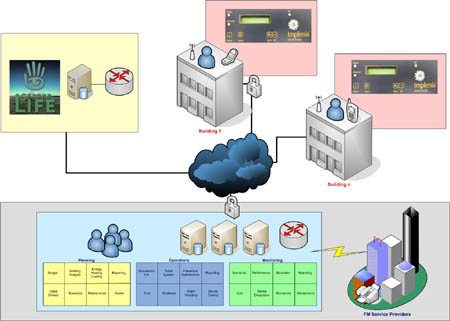
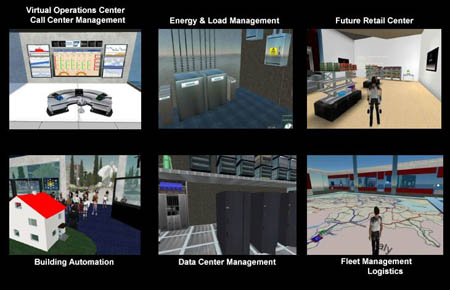
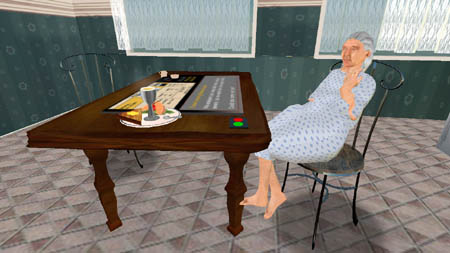
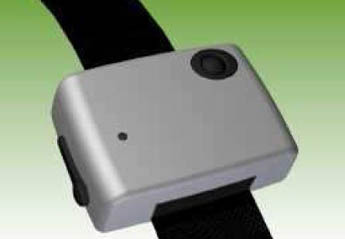
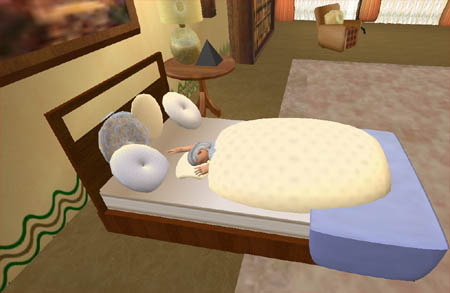

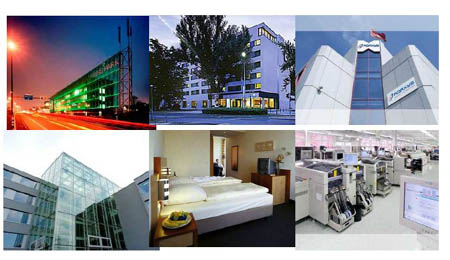

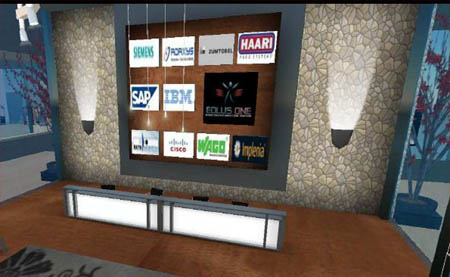

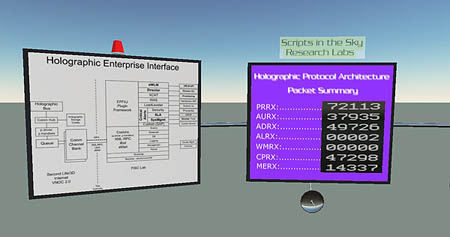
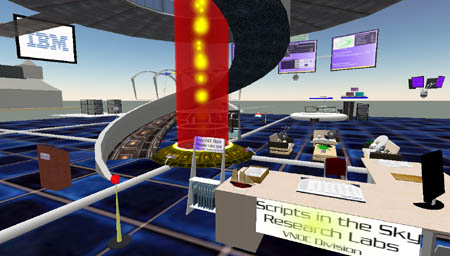
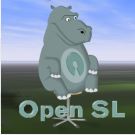
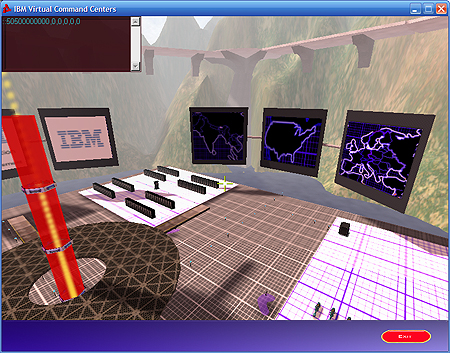
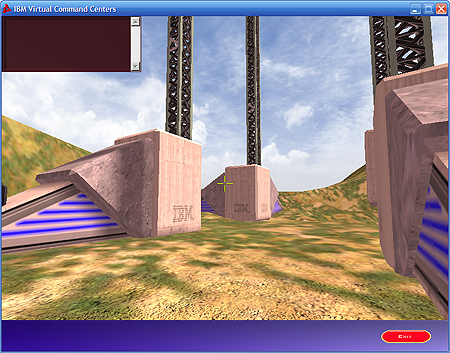
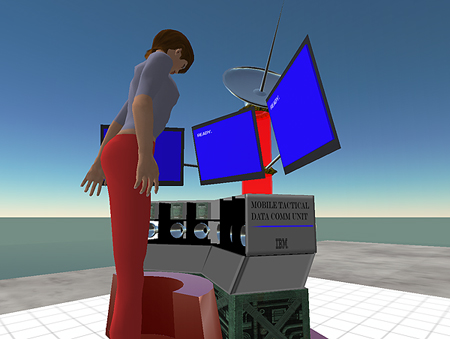
October 23rd, 2007 at 10:44 am
This is one of the best blog posts and pieces of reporting I have read in my short life in virtual space, but I have read a lot. My hat is off to you.